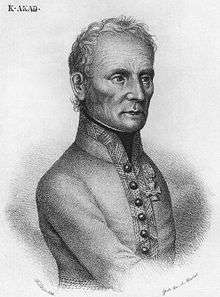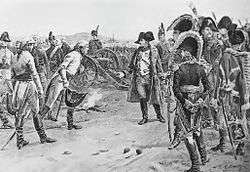Karl Mack von Leiberich
Karl Freiherr Mack von Leiberich (25 August 1752 – 22 December 1828) was an Austrian soldier.[1] He is best remembered as the commander of the Austrian forces that capitulated to Napoleon's Grande Armée in the Battle of Ulm in 1805. Mack makes a brief appearance as a character in book two of Volume I of Tolstoy's War and Peace.
Karl Mack von Leiberich | |
|---|---|
 Karl Mack von Leiberich | |
| Born | 25 August 1752 Nennslingen, Principality of Ansbach |
| Died | 22 December 1828 (aged 76) St. Pölten, Lower Austria |
| Allegiance | |
| Years of service | 1770-1807 |
| Rank | Feldmarschall-leutnant |
| Battles/wars | War of the Bavarian Succession (1778–1779) Austro-Turkish War (1787–1791)
|
| Awards | Military Order of Maria Theresa |
Early career
Karl Leiberich was born at Nennslingen, in the Principality of Ansbach. In 1770 he joined an Austrian cavalry regiment, in which his uncle, Leiberich, was a squadron commander, becoming an officer seven years later. During the brief War of the Bavarian Succession he was selected for service on the staff of Count Kinsky, under whom, and subsequently under the commander-in-chief Field Marshal Count Lacy, he did excellent work. He was promoted first lieutenant in 1778, and captain on the quartermaster-general's staff in 1783. Count Lacy, then the foremost soldier of the Austrian army, had the highest opinion of his young assistant. In 1785 Mack married Katherine Gabrieul, and was ennobled under the name of Mack von Leiberich.[2]
In the Turkish War he was employed on the headquarters staff, becoming in 1788 major and personal aide-de-camp to the emperor, Joseph II and in 1789 was promoted to lieutenant colonel. He distinguished himself in the storming of Belgrade in 1789 [3]. Shortly after this, disagreements between Mack and Ernst Gideon von Laudon, now commander-in-chief, led to the former demanding a court-martial; Mack left the front but received a colonelcy (1789) and the Order of Maria Theresa. In 1790 Laudon and Mack, reconciled, were again on the field together. During these campaigns Mack received a severe head injury from which he never fully recovered. In 1793 he was made quartermaster-general (chief of staff) to Prince Josias of Saxe-Coburg, commanding in the Netherlands and he enhanced his reputation by the ensuing campaign. The young Archduke Charles of Austria, who won his own first laurels in the action of March 1, 1793, wrote after the battle, "Above all we have to thank Colonel Mack for these successes".[2]
French Revolutionary Wars
Mack distinguished himself again on the field of Neerwinden and had a leading part in the negotiations between Coburg and Dumouriez. He continued to serve as quartermaster-general, and was now made titular chief (Inhaber) of a cuirassier regiment. He received a wound at Famars, but in 1794 was once more engaged in active service, having at last been made a major-general. But the failure of the coalition allies, due though it was to political and military factors and ideas, over which Mack had no control, was ascribed to him, as their successes of March–April 1793 had been, and he subsequently fell into disfavour in military circles. The Emperor, now Francis II, remained his supporter and in 1797 Mack was promoted Feldmarschall-leutnant, and in the following year he accepted, at the personal request of the emperor, the command of the Neapolitan army. He could do nothing with the unpromising material of his new command against the French revolutionary troops, and before long, being in actual danger of being murdered by his men, he took refuge in the French camp. Initially, he was promised a free pass to his own country, but Napoleon ordered that he should be sent to France as a prisoner of war.[2]
War of the Third Coalition

Two years later he escaped from Paris in disguise. There were allegations that he broke his parole, a severe allegation that reflected on his honor as a gentleman and an officer (in the opinion of the anonymous author of his biography in the 1911 Eleventh edition of Encyclopædia Britannica this allegation was false).[2]
He was not employed for some years, but in 1804, when the war party in the Austrian court needed a general to oppose the peace policy of the Archduke Charles, Mack was made quartermaster-general of the army, with instructions to prepare for a war with France. He did all that was possible within the available time to reform the army, and on the opening of the war of 1805 he became quartermaster-general to the titular commander-in-chief in Germany, the Archduke Ferdinand Karl Joseph of Austria-Este, who was himself inexperienced in military command. Consequently, Mack held the real responsible commander of the army that opposed Napoleon in Bavaria, but his position was ill-defined and his authority treated with minimal respect by the other general officers. Furthermore, the restructuring of the Habsburg military had been incomplete; Mack chose to initiate some of Charles' innovations, while ignoring others. His own insecurities and vagaries did not encourage the confidence of the staff; in the campaigning that led up to the Battle of Ulm, Mack's frequent reversals of Viennese policy, and even his own decisions, further undermined an already fragile command structure.[2]
At Ulm in October 1805, he surrendered the entire army to Napoleon. A few of his officers, including Prince von Schwarzenberg, broke through the French defenses in a massed cavalry charge and escaped, but most of the Austrian high command was captured with 25,000 men, 18 generals, 65 guns, and 40 standards. The general officers received a parole that required them to abstain from combat with France, removing the bulk of Habsburg commanders from the possibility of service in the upcoming campaign of the Upper Danube.
After Austerlitz, Mack was convicted of cowardice by a court-martial. He was deprived of his rank, his regiment, and his honors, chiefly the Order of Maria Theresa, and imprisoned for two years. Upon his release in 1808, he lived in relative obscurity until 1819, when the ultimate victory of the allies had obliterated the memory of earlier disasters, he was, at the request of Prince Schwarzenberg, reinstated in the army as Feldmarschall-leutnant, and a member of the Order of Maria Theresa. He died on 22 October 1828 at S. Pölten.[2]
Notes
- Regarding personal names: Freiherr is a former title (translated as Baron). In Germany since 1919, it forms part of family names. The feminine forms are Freifrau and Freiin.
- Chisholm 1911, p. 260.
- Bruce, Robert Bowman; Schneid, Frederick S.; Pavkovic, Michael (2008-04-15). Fighting Techniques of the Napoleonic Age: Equipment, Combat Skills, and Tactics. Macmillan. ISBN 978-0-312-37587-4.p. 132
References

- C. A. Schweigerd: Oesterreichs Helden und Heerführer von Maximilian I. bis auf die neueste Zeit in Biographien und Charakterskizzen .... Vienna, 1854
- Constantin von Wurzbach: Biographisches Lexikon des Kaiserthums Oesterreich. Vienna 1856 - 1891.
- Johann Ritter von Rittersberg: Biographien der ausgezeichnetesten Feldherren der k.k. oesterreichischen Armee. Prague, 1828
- The Historisches Taschenbuch (a yearbook founded by Friedrich von Raumer) for 1873 contains a vindication of Mack.
- A short critical memoir will be found in Streffleur (i.e., Österreichische Militärische Zeitschrift) for January 1907.
| Wikimedia Commons has media related to Karl Mack von Leiberich. |
External sources
Ph.D thesis: Gramm, E.R.: "Der unglückliche Mack - Aufstieg und Fall des Karl Mack von Leiberich" http://othes.univie.ac.at/480/1/02-05-2008_7500647.pdf